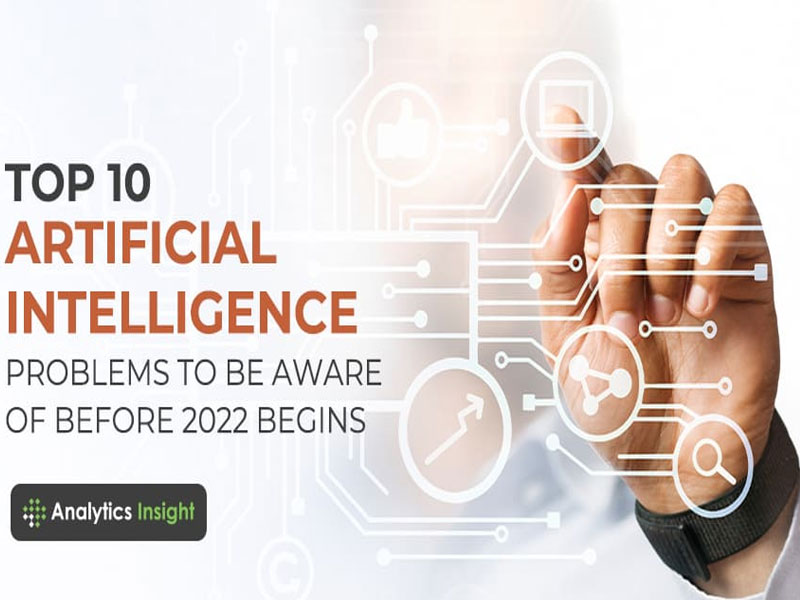AI Is Set To Change Fertility Treatment Forever
SOURCE: HTTPS://CODEBLUE.GALENCENTRE.ORG/
NOV 06, 2023
Top 10 Artificial Intelligence problems to be aware of before 2022 begins
SOURCE: ANALYTICSINSIGHT.NET
DEC 20, 2021

Artificial Intelligence (AI) is the toast of every technology driven company. Integration of AI gives a business a massive amount of transformation opportunities to leverage the value chain. Adopting and integrating AI technologies is a roller-coaster ride no matter how business-friendly it may sound. A Deloitte report says, around 94% of the enterprises face potential artificial intelligence problems while implementing it.
To integrate, deploy and implement AI applications in the enterprise, the organization must have the knowledge of the current AI advancement and technologies as well as its shortcomings. The lack of technical know-how is hindering the adoption of this niche domain in most of the organization. Only 6% enterprises, currently, have a smooth ride adopting AI technologies. Enterprise requires a specialist to identify the roadblocks in the deployment process. Skilled human resources would also help the teamwork with return on in tracking of adopting AI/ML solutions.
Small and mid-sized organizations struggle a lot when it comes to adopting AI technologies as it is a costly affair. Even big firms like Facebook, Apple, Microsoft, Google, Amazon (FAMGA) allocate a separate budget for adopting and implementing AI technologies.
One of the biggest artificial intelligence problems is data acquisition and storage. Business AI systems depend on sensor data as its input. For validation of AI, a mountain of sensor data is collected. Irrelevant and noisy datasets may cause obstruction as they are hard to store and analyze. AI works best when it has a good amount of quality data available to it. The algorithm becomes strong and performs well as the relevant data grows. The AI system fails badly when enough quality data isn’t fed into it.
As mentioned above, adoption and deployment of AI technologies require specialists like data scientists, data engineers and other SMEs (Subject Matter Experts). These experts are expensive and rare in the current marketplace. Small and medium-sized enterprises fall short of their tight budget to bring in the manpower according to the requirement of the project.
The implementation of AI applications comes with great responsibility. Any specific individual must bear the burden of any sort of hardware malfunctions. Earlier, it was relatively easy to determine whether an incident was the result of the actions of a user, developer or manufacturer.
One of the major AI problems that are yet to be tackled are the ethics and morality. The way the developers are technically grooming the AI bots to perfection where it can flawlessly imitate human conversations, making it increasingly tough to spot a difference between a machine and real customer service rep. Artificial intelligence algorithms predict based on the training given to it. The algorithm will label things as per the assumption of data it is trained on. Hence, it will simply ignore the correctness of data, for example- if the algorithm is trained on data that reflects racism or sexism, the result of prediction will mirror back it instead of correcting it automatically.
AI, machine learning and deep learning solutions require a high degree of computation speeds offered only by high-end processors. Larger infrastructure requirements and pricing associated with these processors has become a hindrance in their general adoption of the AI technology. In this scenario, cloud computing environment and multiple processors running in parallel offer a potent alternative to cater to these computational requirements. As the volume of data available for processing grows exponentially, the computation speed requirements will grow with it. It is imperative to develop next-gen computational infrastructure solutions.
An AI application with an erroneous algorithm and data governance can cause legal challenges for the company. This is yet again one of the biggest aArtificial iIntelligence problems that a developer faces in a real world. Flawed algorithm made with an inappropriate set of data can leave a colossal dent in an organization’s profit. An erroneous algorithm will always make incorrect and unfavorable predictions. Problems like data breach can be a consequence of weak & poor data governance–how? To an algorithm, a user’s PII (personal identifiable information) acts as a feedstock which may slip into the hands of hackers. Consequently, the organization will fall into the traps of legal challenges.
There’s quite a discrepancy between the actual potential of the AI system and the expectations of this generation. Media says that artificial iIntelligence, with its cognitive capabilities, will replace human’s jobs. However, the IT industry has a challenge on their hands to address these lofty expectations by accurately conveying that AI is just a tool that can operate only with the indulgence of human brains. AI can definitely boost the outcome of something that will replace human roles like automation of routine or common work, optimizations of every industrial work, data-driven predictions, etc.
In any emerging field, tech procurement is quite challenging as AI is particularly vulnerable. Businesses face a lot of problems to know how exactly they can use AI effectively as many non-AI companies engage in AI washing, some organizations overstate. It’s true that AI technology is a luxurious retreat because you cannot oversee the radical changes it brings into the organization. However, to implement it an organization needs experts who are hard to find. For successful adoption, it needs a high-degree computation processing. Enterprises should concentrate on how they can responsibly mitigate these artificial intelligence problems rather than staying back and ignoring this ground-breaking technology.
LATEST NEWS
Augmented Reality
Hi-tech smart glasses connecting rural and remote aged care residents to clinicians
NOV 20, 2023
WHAT'S TRENDING


Data Science
5 Imaginative Data Science Projects That Can Make Your Portfolio Stand Out
OCT 05, 2022

SOURCE: HTTPS://CODEBLUE.GALENCENTRE.ORG/
NOV 06, 2023
SOURCE: HTTPS://WWW.NEWS-MEDICAL.NET/
NOV 06, 2023
SOURCE: HTTPS://WWW.WIRED.COM/
NOV 05, 2023
SOURCE: HTTPS://WWW.BUSINESSOUTREACH.IN/
OCT 31, 2023
SOURCE: HTTPS://WWW.DIGITALMUSICNEWS.COM/
SEP 13, 2023
SOURCE: HTTPS://PULSE2.COM/
AUG 27, 2023
SOURCE: HTTPS://TECHCRUNCH.COM/
AUG 18, 2023